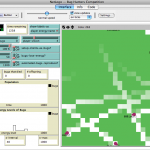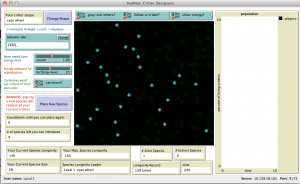Population Biology/Ecology has strong claims to importance and relevance to students. In this time of enormous manmade effects on species, endangered and invasive species, epidemics, rising rates of extinction and rapid climate change, an understanding of the dynamics of biological populations, predator prey interactions and species/environment dependencies, is a necessary requirement for managing that impact. A first step is an understanding of the dynamics and characteristic patterns of population change. Moreover, such an understanding is preparatory and fundamental to understanding evolution: as biodiversity, carrying capacity of an environment, ecological niches and characteristic boom-bust cycles provide the theoretical substrate on which evolutionary mechanisms and natural selection can operate. Despite its importance, little more than qualitative understanding can be achieved in traditional secondary school treatments as the mathematics is a barrier.
The agent-based approaches adopted by the computational models in this unit can deliver both qualitative and quantitative models with minimal algebraic formalism yet powerful modeling capability. In addition, these models serve as powerful test-beds for students to design and conduct experiments to analyze data and construct scientific explanations for the mechanisms and patterns underlying population dynamics. Each activity begins with a pre-class discussion to introduce students to the central question of the activity and to elicit students’ prior ideas about the topic. After students have interacted with the model, either alone or in small groups, the teacher facilitates a consensus-building discussion in class to synthesize what students learned. This state-of-the-art curriculum has been designed to closely align with the Next Generation Science Standards in terms of the scientific practices that students engage in as well as the performance expectations and disciplinary core ideas addressed in the unit.
Overview of Activities
1. Introduction to Ecosystems: How do ecosystems change?
Purpose:
This introductory activity is designed to meet three goals: To elicit student thinking about population change in ecosystems, generate a set of student-driven questions about population change and related phenomena, and connect these questions to the driving question of the unit.
Description
Students observe a photograph of a real world ecosystem and describe some of the changes they expect to see in that ecosystem over the course of a week, a year, 30 years, and a thousand years, a million years, and a billion years. They brainstorm what type of evidence they might collect to determine how the ecosystem may have changed in the past and how one population of organism may have changed in the past. They pose questions about how populations change over time and link these to a driving question board that is used to focus and organize the arc of investigations and inquiry throughout the unit.
2. Modeling Interactions in Ecosystems: What types of interactions occur in ecosystems?
Purpose
In this activity, the goal is to describe the kinds of interactions that can occur between organisms and their environment in an ecosystem, and to describe these interactions in terms of direct/indirect effects and immediate/delayed outcomes.
Description
Students observe photographs of a real world ecosystem to describe some of the organisms in the ecosystem and the interactions that might be occurring in it. Through whole-class discussion, the class develops a definition for an “ecosystem” and an “interaction”. The students build a physical food web of a pond ecosystem as an entire class, representing the direct predator/prey interactions and direct consumer/producer interactions using string and index cards. The class uses this model of the food web to visualize and discuss various forms of interactions between populations, describing indirect and delayed effects on population size. At the end of class, the teacher develops a class consensus on the types of interactions that occur in ecosystems, indirect vs. direct effects, and immediate vs. delayed outcomes. The class also discusses using a physical model of an ecosystem to help them understand, predict, and explain various outcomes.
3. Competition between Individuals: What causes competition between individuals in an ecosystem?
Purpose:
This activity has been designed to help students understand how competition emerges unintentionally from the interactions between consumers and producers for resources that are necessary for survival.
Description
In this activity, students engage in a participatory simulation where each student plays the role of a consumer in a predator-prey ecosystem. In the first two explorations, students control the movement of a bug and try to eat as much food (grass) as possible under various conditions. In the final exploration, they observe the outcome when many bugs move randomly and blindly around an ecosystem consuming food without any intentional control. In each exploration, students predict how the populations will change, and compare their predictions to the outcomes they observe.
Based on these explorations, and the data they collect, students recreate a physical representation of a histogram graph (of energy levels of bugs) from the model and analyze characteristics of the population in the graph.
The teacher facilitates a whole-class discussion to gain consensus on the idea that competition is an emergent outcome that results from 1) limited resources necessary for survival, 2) unequal distribution of those resources throughout the ecosystem, and 3) intentional actions on part of the individuals or from the unintentional interactions that are occurring between each individual and their environment.
4. Fluctuation and Stability: How do population sizes in an ecosystem change over time?
Purpose:
This activity is intended to meet three goals: 1) to identify relative stability and change in population sizes over time, 2) describe direct and indirect interactions between populations that lead to stability and change, and 3) describe how some indirect effects in one population lead to delayed outcomes in other populations, some of which are temporary, others of which are more sustained.
 Bug Hunt Consumers NetLogo Model
Bug Hunt Consumers NetLogo Model
Description
In this activity, students run experiments using a computer model to explore interactions between a consumer and producer population. Students make predictions about the relationship between amount of resources available in an environment and the stability of the population size of bugs living in that environment. From their model runs, students record their observations about fluctuations in population size and stable states (equilibrium levels) for each population.
The teacher then facilitates a whole-class discussion to help students make sense of the mechanisms underlying relative stability of a population under certain environmental conditions despite fluctuations (minor and cyclical fluctuations). They discuss how counterbalancing forces of deaths and births affect the amount of food available per individual in the ecosystem. Finally, they discuss how sustained environmental changes lead to new stable states for the ecosystem.
5. Static Designs of Populations: How do populations affect each other in ecosystems?
Purpose:
This final activity in the population dynamics unit helps students understand how populations indirectly compete against each other by applying concepts learned previously in this unit.
 Critter Designers NetLogo Model
Critter Designers NetLogo Model
Description
Students use a computer model to investigate interactions between producers, consumers and predators, noting the delayed effects between population peaks in each population. They adjust the attributes of all the individuals in one population to see how such changes affect the carrying capacity of that population. Students also introduce an invasive species in the model to investigate how the invasive population and the native consumers compete against each other. Students develop explanations for how environmental conditions affect whether the invasive and native species both survive or one of the species dies out.
Using the Unit in Your Classroom
The activities in this unit have been pilot-tested in high school biology classes through the last few years, to revise and refine the materials based on our own research findings and feedback from teachers and students. These pilot-tests have helped us develop a better understanding of how this unit helps students learn about population dynamics. First, the visualization of the ecosystem along with the dynamically updating plots provide students with immediate access to how the populations are changing over time, both by representing an aggregate view of the change (plots) as well as the state of individual organisms in the system (visualization of the ecosystem). These dual representations are leveraged by students to develop scientific explanations for how the populations are changing, as well as why they are changing over time. Very often, we notice students getting “hooked on” to a particularly surprising trend in the plot – a sudden dip in the population of consumers, or a population going extinct – re-running the model to check if it was a chance coincidence or a real trend, and then engaging in heated discussions with peers or the teacher to make sense of the plot.
Besides engaging students in authentic inquiry activities, another particularly unique aspect of this unit is enabling students to “step into the system” by playing the role of a consumer in it. Stepping into the system to manipulate the actions of an individual makes the simulation more transparent as students observe that the dynamically updating plots in the model are depicting the outcomes of the cumulative actions of their class. We have found that one of the most remarkable strengths of “stepping into the system” is that it bootstraps the interpretation of plots. Students draw on their own actions and strategies as participants in the system to make sense of the trends in the plot.
